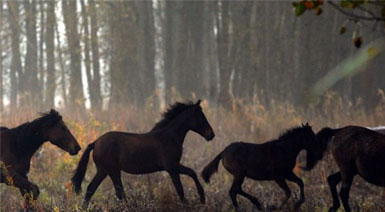by Rona Fried
This bit of bad news actually made it into mainstream media this past week – that half of our planet’s wildlife is gone, and it’s happened in the past 40 years.
The biggest cause of this collapse is over-hunting, poaching and over-fishing, followed by habitat destruction and degradation, and then climate change – which will become more significant in the coming years – says World Wildlife Fund’s Living Planet report.
Freshwater species have declined the most at 76% and marine and terrestrial species are both down 39%.
The good news is that populations spring back when given a chance. In Nepal, where tigers are protected, their numbers rose 63% in just five years. Ecotourism in Uganda and Rwanda is helping gorilla populations there and a growing network of marine preserves sets the stage for a corresponding rebound.
Rewilding in Europe
While proponents in the US have long proposed "rewilding" parts of our vast country, Europe is actually moving on restoring its lost wilderness.
Much of Europe’s farmland is falling into disuse because of socio-economic and lifestyle changes, and thanks to Rewilding Europe, wildlife is flowing in.
The group is taking advantage of the opportunity by seeding the land with herds of wild horses, European bison, red deer and ibex – grazing animals that thrived there before human intervention. Also back are bears, wolves and lynx that naturally keep those populations in balance. The idea is to return the land back to nature, supported by a thriving ecotourism industry.
They hope to have projects on 2.4 million acres of land by 2020.

As part of their 10 initial projects,
Ibex are being re-introduced around two national parks on the Croatian coast, and European bison are returning to abandoned farms in Romania’s Carpathian Mountains.
While bisons keep the landscape open by eating shrubs and trees, wild horses keep the grass very short, allowing a wide variety of plants and other animals to return. They debark trees, opening up closed forests, which brings a variety of forest trees back, explains Rewilding Europe.
Allowing these animals to roam wild is also critical to these endangered populations. There are just 3000 European bisons left and that’s because 54 of them have been protected in zoos. Wild horses are even more rare. After grazing on every kind of ecosystem from deserts to mountains, they were completely domesticated by 1909. Through the "The Tauros Programme" they hope to bring back the cow’s ancestor, aurochs, hunted to extinction in 1627. Their DNA lives on in some ancient cattle breeds.
The group has strong support from conservation groups such as WWF Netherlands, ARK Nature, Wild Wonders of Europe, and Conservation Capital.
There’s even a financing arm for people who want to help called Rewilding Europe Capital. Tourism operators, landowners, and businesses that make products from the wildlands, such as honey and berries, can all get loans and even grants.
Impressive for a group that formed a year ago!
Visit Rewilding Europe:

If only we in the U.S. were so forward thinking
it’s so wonderful to see a little intelligence
in this sick world
It’s aurochs, not auroch, as a singular noun.
While I strongly support rewilding efforts, the TaurOs Programme’s aim to create ” a near 100 % substitute for the Aurochs: the Tauros, a bovine breed that will be indistinguishable from the former Aurochs,” is not possible. Just as with the efforts to recreate the passenger pigeon in the US, the result will be an approximation–a very close one, perhaps–but still an approximation. Extinction is irreversible.